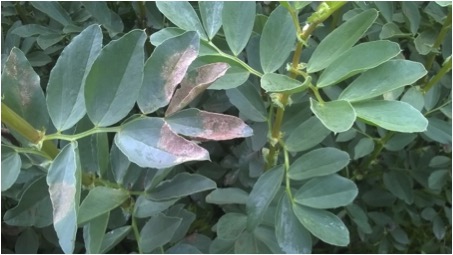Winter Beans Update – October 2020
1 October 2020Pre-emergence weed control
Weed pressure in winter beans tends to be low due to the later sowing date when fewer weeds germinate. However, beans are sown at a very low seed rate so there is plenty of room for any weeds that do germinate to develop into a problem. Volunteer cereals can need controlling, and on farms that have brome or black-grass, winter beans give an excellent opportunity to try to prevent seed return of these problem weeds for one year at least.
Where grass weeds are the issue, a stale seedbed prior to sowing is definitely worthwhile – for both brome and black-grass. For barren or great brome and for black-grass the advice is to surface cultivate (5 cm) after harvest to encourage germination then spray off with glyphosate. In fields that have meadow, rye or soft brome seed should be left to ripen on the soil surface for a month before shallow cultivating and spraying off emerged weeds with glyphosate.
Apart from ‘fop’ and ‘dim’ graminicides, there are limited post-emergence herbicide options in winter beans so it is worth getting on with a residual. This must be applied before emergence of both crop and weeds – at the time of year when beans are sown germination tends to be slow so there is a bit of time to get the spray on.
There are several pre-emergence herbicide options – all control annual meadow-grass and some broad-leaved weed species. Selectivity relies on a layer of settled soil separating the beans from the herbicide, for instance if using imazamox + pendimethalin there must be at least 2.5 cm of settled soil.
Some herbicide options:
- Pendimethalin is probably the least expensive and has a broad weed spectrum although it is weaker a few species, for example cleavers, mayweeds, fumitory, shepherd’s purse and polygonums.
- Clomazone has a narrow weed spectrum but is better on cleavers. It can be tank mixed, or there is a formulated clomazone + pendimethalin product.
- Imazamox + pendimethalin has probably the widest weed spectrum. The addition of imazamox fills some of the gaps of pendimethalin, but it is weak on weeds such as field pansy, scentless mayweed and shepherd’s purse,
- Prosulfocarb controls a range of broad-leaved weeds, annual meadow-grass and a reduction of black-grass.
Propyzamide is the herbicide of choice if there is a grass weed problem. There needs to be a fine tilth and it should be applied within 7 days of sowing. Check the label for soil type restrictions. At the black-grass and brome dose rate it controls black-grass, barren brome, volunteer cereals, wild oat and some broad-leaved weeds including polygonums chickweed and speedwells. The benefit of propyzamide is that it controls black-grass populations resistant to other herbicide groups. It is root acting and kills grass weeds that have germinated in the top 2 cm of soil – so it is most effective in crops established with minimum soil disturbance.
Note that propyzamide is one of the herbicides detected in water – recent work has shown that lowest losses to drainage water are in crops established with minimal soil disturbance. Product stewardship guidelines must be adhered to:
How to stop propyzamide reaching water.
- Take care when filling and cleaning the sprayer
- Use 6m grass buffer strip, or 5m no-spray zone, beside water courses.
- Discuss cultivation and spray timing with your BASIS registered adviser.
- Manage soils and tramlines to avoid surface run-off or erosion.
- Do not apply when soils are cracked, dry or saturated.
- Do not apply propyzamide if heavy rainfall is expected within 48 hours of application.
How best to use the products
- Propyzamide works best when applied to cold moist soils, but this must be balanced with the need to protect water. Soils do not need to be completely saturated. Where practical, avoid use if drains are flowing or are likely to flow in the near future.
Dose
- Only use the maximum rate of 840g a.i./ha for severe black-grass situations. Lower dose rates of 700g a.i./ha or 500g a.i./ha are recommended for less severe black-grass, other grasses and broad-leaf weeds (see product labels for details).
Additional safeguards are needed in high risk areas – click here to see the Voluntary Initiative Water Advice Sheet
Always check the label of pre-emergence herbicides for any soil texture or other restrictions.
Sign up to the FAS newsletter
Receive updates on news, events and publications from Scotland’s Farm Advisory Service

